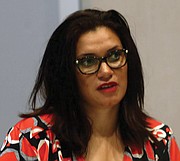Council members concerned about latest utility rate hikes
Jeremy M. Lazarus | 5/10/2019, 6 a.m.
Like a steady drip, drip, drip, the cost of utility services is continuing to rise in Richmond at a double-digit pace, outpacing inflation and raising concerns among some about affordability.
Beginning July 1 when the new budget year begins, the combined increase in rates for water, sewer and natural gas service once again will rise by double digits — 11.5 percent — with an additional 4 percent increase in the rate for stormwater service for property owners.
Like past administrations, the administration of Mayor Levar M. Stoney has sought to minimize the impact of the increase on household budgets, telling City Council that the average utility customer would pay an extra $5.82 each month.
According to a statement from the administration, the city Department of Public Utilities is proposing on average, per single family residential customer, a $1.86 monthly increase for gas and a $3.96 increase for all three water utilities — water, wastewater and stormwater.
But that’s just this year, and only for small users. The impact is likely to be larger on businesses and apartment building owners.
And it doesn’t take into account the increases of the past and the coming increases, according to two City Council members, Kim B. Gray, 2nd District, and Reva M. Trammell, 8th District, who were unsuccessful in seeking to roll back the proposed utility rate increases.
Mayor Stoney and the department received a majority of the council’s support with their argument that the hike in rates was essential to maintain service, meet all federal and state regulations and enable the department to continue to borrow at low interest for its program to upgrade or replace the city’s aging infrastructure of underground pipes that dates back more than a century.
In addition, the increase is needed, the administration stated, in order for DPU to continue to support the general fund budget with PILOT payments, or payments in lieu of taxes.
Under the City Charter, DPU is required to pay into the city treasury an amount equal to the taxes it would pay if it were a private business.
Mayor Stoney’s budget proposal was based on securing a DPU PILOT of $20 million to support the general fund, which goes to pay for police, fire service, street paving and a host of other city services.
When council considered the Gray-Trammell plan to eliminate the proposed rate utility increases, the administration swiftly notified the council that such action would strip $4 million from DPU’s projected PILOT payment, and the administration requested from the council information on how that $4 million reduction to the general fund would be replaced. The Gray-Trammell proposal quickly died.
Still, the steady rate increases have had an impact on family and business budgets. DPU data on rate increases beginning with the 2007-2008 budget year tell the story.
The data show the gas rate in the upcoming 2019-20 budget year will be 34.5 percent higher than 2007-08, the water rate will be 76 percent higher, the wastewater rate almost 60 percent higher and the stormwater rate 14 percent higher.
The impact is due to the compounding effect. Each earlier increase in the rate remains in place, and the new rate increase is a fresh jump.
Based on the assumptions of no rate declines and that a customer in 2007 was billed $100 monthly each for water and wastewater service or $200 total, the annual rate increases mean the bill for the combined services would be $390.17 in the 2019-20 budget year, a nearly 100 percent increase. (The actual increase is a bit smaller as the base rate for the first 2,992 gallons of residential water use was reduced several years ago.)
The rate increases have had less impact on natural gas. A $100 gas bill in 2007 would be $138.75 in 2019-20 based on the rate increases. That does not include the additional charge for the natural gas the city buys and has piped in.
Stormwater utility rates began rising in the 2017-18 budget year and will have increased 14 percent effective with the new budget year beginning July 1.
Since the 2007-08 budget year, the annual rate increases have been below 10 percent only once. In the 2010-11 fiscal year, the rate increase totaled 8 percent for natural gas, water, sewer and stormwater. In every other year, the total percentage increase has ranged from 11.5 percent to 19.25 percent.
In each of the next four budget years, DPU is projecting an increase in rates of 15.5 percent to 16 percent for the four utilities. Water and sewer utility rates, alone are to rise a combined 7.5 percent to 8 percent each year.
Ms. Gray and Ms. Trammell expressed concern that the continuing rising cost of essential utilities is squeezing seniors living on fixed incomes and others who live paycheck to paycheck.
“We’re going to drive people out of the city,” Ms. Gray argued in warning her City Council colleagues about the impact of the rate increases. As a single mother, she said that she, too, is feeling the pinch. “Every dollar matters. I just can’t afford to have the rates keep going up and up.”
Ms. Trammell, too, expressed concern. “I am getting calls from people who wonder how they are going to pay their utility bills. This is not fair. This is not right.”









